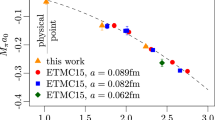Abstract
The s-wave kaon–antikaon ( ) scattering length is studied by lattice QCD using pion masses m
π
=330–466 MeV. Through wall sources without gauge fixing, we calculate
) scattering length is studied by lattice QCD using pion masses m
π
=330–466 MeV. Through wall sources without gauge fixing, we calculate  four-point functions in the I=1 channel with the “Asqtad”-improved staggered fermion formulation, and observe an attractive signal, which is consistent with pioneering lattice studies on
four-point functions in the I=1 channel with the “Asqtad”-improved staggered fermion formulation, and observe an attractive signal, which is consistent with pioneering lattice studies on  potential. Extrapolating the
potential. Extrapolating the  scattering length to the physical point, we obtain
scattering length to the physical point, we obtain  , where the first error is statistical and the second is systematic. These simulations are conducted with MILC gauge configurations at lattice spacing a≈0.15 fm.
, where the first error is statistical and the second is systematic. These simulations are conducted with MILC gauge configurations at lattice spacing a≈0.15 fm.







Similar content being viewed by others
Notes
Our phase conventions for pseudoscalar mesons are different from those in Ref. [1].
The errors for vacuum amplitudes should be roughly independent of t, and grow exponentially as e^2m_Kt in the ratio R V . While for the rectangular diagram R s , it increases as \(\displaystyle e^{m_{s\bar{s}} t}\), where \(m_{s\bar{s}}\) is a fictitious meson with two valence quarks with mass about m s (see Ref. [43] for the calculation of \(m_{s\bar{s}}\)). Thus, the reliable calculations of these terms are beyond the scope of this paper since it requires a substantial amount of computing resources.
Zhi-Hui Guo give the following formula to me for fitting our lattice data. We especially thank him. Without his kind help, we could not have finished this work properly. Nevertheless, in this work, we use f π =132 MeV instead of 92 MeV as in Guo’s original formula.
References
J.A. Oller, E. Oset, J.R. Pelaez, Phys. Rev. D 59, 074001 (1999). arXiv:hep-ph/9804209
P. Winter et al., Phys. Lett. B 635, 23 (2006). arXiv:hep-ex/0602030
Y. Maeda et al. (The ANKE Collaboration), Phys. Rev. C 77, 015204 (2008). arXiv:0710.1755 [nucl-ex]
A. Dzyuba et al., Phys. Lett. B 668, 315 (2008). arXiv:0807.0524 [nucl-th]
Y. Maeda et al., Phys. Rev. C 79, 018201 (2009). arXiv:0811.4303 [nucl-ex]
M. Silarski et al. (COSY-11 Collaboration), Phys. Rev. C 80, 045202 (2009). arXiv:0909.3974 [hep-ph]
J.J. Xie, C. Wilkin, Phys. Rev. C 82, 025210 (2010). arXiv:1005.2957 [nucl-th]
B. Lorentz et al., J. Phys. Conf. Ser. 295, 012146 (2011)
M. Silarski, Int. J. Mod. Phys. A 26, 539 (2011). arXiv:1008.3620 [hep-ph]
N.N. Wong, A.N. Kamal, Phys. Rev. D 11, 1896 (1975)
F. Guerrero, J.A. Oller, Nucl. Phys. B 537, 459 (1999). arXiv:hep-ph/9805334
R.W. Griffith, Phys. Rev. 176, 1705 (1968)
J.A. Oller, E. Oset, Nucl. Phys. A 620, 438 (1997)
J.A. Oller, E. Oset, Phys. Rev. D 60, 074023 (1999). hep-ph/9809337
M. Doring, U.G. Meissner, E. Oset, A. Rusetsky, Eur. Phys. J. A 47, 139 (2011). arXiv:1107.3988 [hep-lat]
A. Gomez Nicola, J.R. Pelaez, Phys. Rev. D 65, 054009 (2002). arXiv:hep-ph/0109056
A. Mihály, Studies of meson–meson interactions within lattice QCD. Ph.D. thesis, Lajos Kossuth University, Debrecen (1998)
A. Mihaly, H.R. Fiebig, H. Markum, K. Rabitsch, Heavy Ion Phys. 9, 349 (1999)
S.R. Beane et al., Phys. Rev. D 77, 094507 (2008). arXiv:0709.1169 [hep-lat]
Z. Fu, Phys. Rev. D 85, 074501 (2012). arXiv:1110.1422 [hep-lat]
Z. Fu, J. High Energy Phys. 1201, 017 (2012). arXiv:1110.5975 [hep-lat]
Z. Fu, Phys. Rev. D 85, 014506 (2012). arXiv:1110.0319 [hep-lat]
Z. Fu, Commun. Theor. Phys. 57, 78 (2012). arXiv:1110.3918 [hep-lat]
Z. Fu, J. High Energy Phys. 1207, 142 (2012). arXiv:1202.5834 [hep-lat]
M. Luscher, Nucl. Phys. B 354, 531 (1991)
L. Lellouch, M. Luscher, Commun. Math. Phys. 219, 31 (2001)
J. Beringer et al. (Particle Data Group), Phys. Rev. D 86, 010001 (2012)
K. Orginos, D. Toussaint (MILC Collaboration), Phys. Rev. D 59, 014501 (1998)
K. Orginos, D. Toussaint, R.L. Sugar (MILC Collaboration) Phys. Rev. D 60, 054503 (1999)
C. Bernard et al., Phys. Rev. D 83, 034503 (2011)
A. Bazavov et al., Rev. Mod. Phys. 82, 1349 (2010)
Y. Kuramashi, M. Fukugita, H. Mino, M. Okawa, A. Ukawa, Phys. Rev. Lett. 71, 2387 (1993)
M. Fukugita, Y. Kuramashi, M. Okawa, H. Mino, A. Ukawa, Phys. Rev. D 52, 3003 (1994)
Z.H. Guo, J.A. Oller, Phys. Rev. D 84, 034005 (2011)
S.R. Sharpe, R. Gupta, G.W. Kilcup, Nucl. Phys. B 383, 309 (1992)
J. Nagata, S. Muroya, A. Nakamura, Phys. Rev. C 80, 045203 (2009)
T. Yamazaki et al., Phys. Rev. D 70, 074513 (2004)
D. Barkai, K.J.M. Moriarty, C. Rebbi, Phys. Lett. B 156, 385 (1985)
A. Mihaly, H.R. Fiebig, H. Markum, K. Rabitsch, Phys. Rev. D 55, 3077 (1997)
Z. Fu, Chin. Phys. Lett. 28(8), 081202 (2011)
Z. Fu, Chin. Phys. C 37, 1079 (2011)
G.P. Lepage, in Proceedings of TASI’89 Summer School, ed. by T. DeGrand, D. Toussaint (World Scientific, Singapore, 1990), p. 97
C.W. Bernard et al., Phys. Rev. D 64, 054506 (2001). arXiv:hep-lat/0104002
J. Gasser, H. Leutwyler, Nucl. Phys. B 250, 465 (1985)
X. Feng, K. Jansen, D.B. Renner, Phys. Lett. B 684, 268 (2010). arXiv:0909.3255 [hep-lat]
Acknowledgements
This work is supported in part by Fundamental Research Funds for the Central Universities (2010SCU23002). We thank the MILC Collaboration for using their lattice ensemble. We should thank Eulogio Oset for encouraging and constructive comments, and Zhi-Hui Guo and Hou Qing for their kind help. The computations for this work were done at AMAX, CENTOS and HP workstations in the Institute of Nuclear Science & Technology, Sichuan University.
Author information
Authors and Affiliations
Corresponding author
Appendices
Appendix A: I=1  scattering amplitudes in terms of quark propagators
scattering amplitudes in terms of quark propagators












Appendix B: The analytic expression of s-wave  scattering length for the isospin I=1 channel
scattering length for the isospin I=1 channel
In the isospin limit, both isospin amplitudes in  can be described by two independent amplitudes T
ch (the amplitude for the processes K
+
K
−→K
+
K
−) and T
neu (that for
can be described by two independent amplitudes T
ch (the amplitude for the processes K
+
K
−→K
+
K
−) and T
neu (that for  ) [1, 11, 16]. Z.H. Guo and J.A. Oller derived two isospin amplitudes only in terms of T
neu [34]. Here we follow the notation and conventions in [34], since the chiral scale μ dependence in amplitude is canceled by the loops and the low-energy constants (LECs) [34].
) [1, 11, 16]. Z.H. Guo and J.A. Oller derived two isospin amplitudes only in terms of T
neu [34]. Here we follow the notation and conventions in [34], since the chiral scale μ dependence in amplitude is canceled by the loops and the low-energy constants (LECs) [34].
These amplitudes can be decomposed into partial waves t l (s) according to
where l is total angular momentum, θ denotes scattering angle in the center-of-mass system. In the elastic region, the partial wave amplitude t l (s) can be parameterized by real phase shifts δ l (s),
Its real part can be expanded at threshold (namely, \(s=4m_{K}^{2}, t=0, u=0\)) in terms of the scattering lengths (\(a_{l}^{I=1}\)) and effective ranges (\(b_{l}^{I=1}\)),
for the center-of-mass three-momentum of the kaons q. The s-wave scattering length is linked to the real part of the amplitude at threshold by

The one-loop order analytic expressions of  scattering amplitudes in the isospin limit can be found in Ref. [34], however, no analytic formulas for s-wave scattering lengths were explicitly provided. We, therefore, will present it for the isospin I=1 channel. To this end, we first expand the scattering amplitude at threshold, namely,Footnote 3
scattering amplitudes in the isospin limit can be found in Ref. [34], however, no analytic formulas for s-wave scattering lengths were explicitly provided. We, therefore, will present it for the isospin I=1 channel. To this end, we first expand the scattering amplitude at threshold, namely,Footnote 3

where  are low-energy constants defined in Ref. [44] at the chiral symmetry breaking scale μ. The loop function
are low-energy constants defined in Ref. [44] at the chiral symmetry breaking scale μ. The loop function  is given in Ref. [44], namely,
is given in Ref. [44], namely,

with
By plugging the leading order relation \(m_{\eta}^{2} = (4m_{K}^{2}-m_{\pi}^{2})/3\) [34] we can simplify the above formula as

The scattering length can be written in compact form,

where  is for the known functions at NLO, which clearly depend on the chiral scale μ with chiral logarithm terms,
is for the known functions at NLO, which clearly depend on the chiral scale μ with chiral logarithm terms,

Rights and permissions
About this article
Cite this article
Fu, Z. Preliminary study of the  scattering length from lattice QCD.
Eur. Phys. J. C 72, 2159 (2012). https://doi.org/10.1140/epjc/s10052-012-2159-y
scattering length from lattice QCD.
Eur. Phys. J. C 72, 2159 (2012). https://doi.org/10.1140/epjc/s10052-012-2159-y
Received:
Revised:
Published:
DOI: https://doi.org/10.1140/epjc/s10052-012-2159-y





 scattering amplitudes in terms of quark propagators
scattering amplitudes in terms of quark propagators scattering length for the isospin I=1 channel
scattering length for the isospin I=1 channel